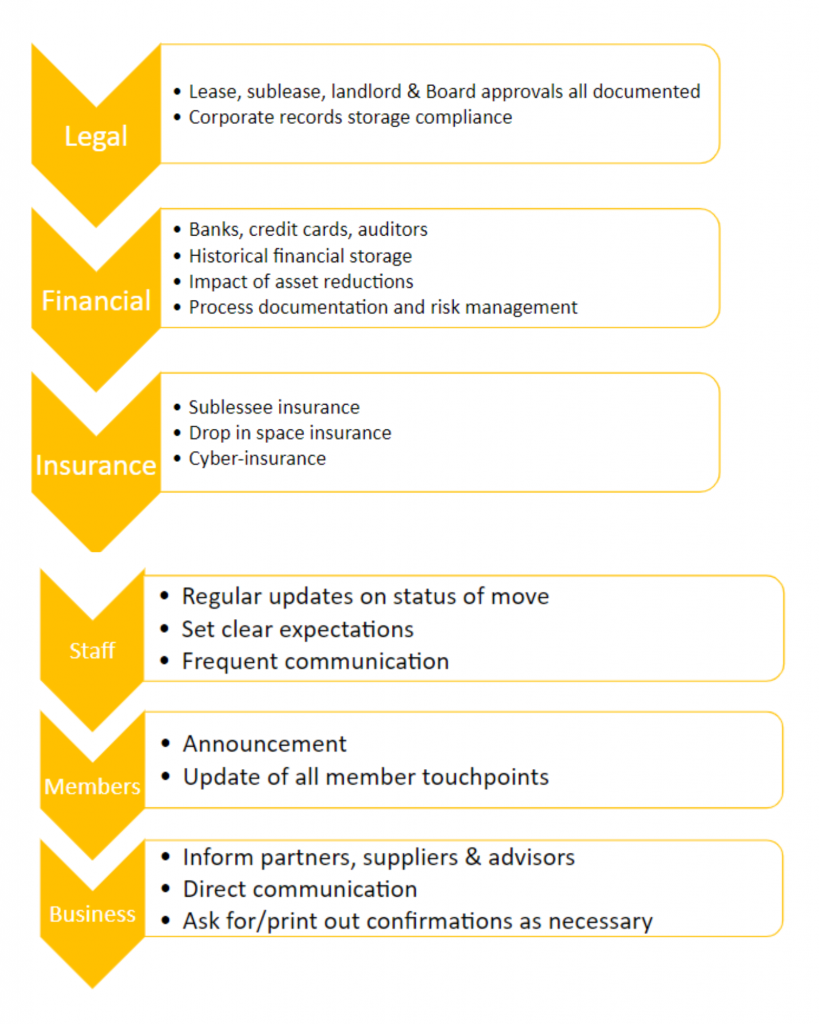Shifting to Virtual Operations: A Recipe for Success


CSAE closed its King Street, Toronto office doors on March 13, 2020 due to the COVID-19 pandemic. The original plan was to be back in the office in a few short weeks. However, some swift and important changes followed, eventually leading CSAE to make a permanent move from a bricks-and-mortar office environment to virtual operations in January 2021. What was CSAE’s recipe for success while shifting to virtual operations? Our ingredients for organizational success are as follows:
- Contextualizing
- Collaborative decision-making
- Careful planning
- Adapting in the face of setbacks
- Keeping the team connected in a virtual environment
- Fostering strong connections with members
The Context
To begin, no recipe for success is complete without considering the context warranting a change to the business model. It is important to determine if a virtual office suits your company’s needs. CSAE carefully considered the context preceding the switch. It also weighed the cost and benefits to support success.
Rhonda McIntyre CAE, senior director of finance and corporate services at CSAE, oversaw the transition from the King Street, Toronto office. She noted: “In 2019 we’d already discussed the potential for a shift to virtual operations in 2024 when our office lease would expire. We’d had an opportunity to operate remotely during a six-week office renovation in 2018. Then, the pandemic hit in early 2020. After seven months of virtual operations due to the pandemic, we decided to consider this as a more permanent shift and looked to sublet our downtown Toronto office space.”
In 2020, CSAE moved forward, backed by the confidence and support of CSAE’s Board of Directors.
Collaborative Decision-making Through Teamwork
Further, collaboration and teamwork were key.
Rhonda explained: “There was no single hero, and groups gathered and assisted each other all the way through. If I perceived a concern coming up, I needed only to send out an email to the team to find someone who was willing to step in to help”.
CSAE’s focus remained on the needs of employees and members throughout the process. Everyone on the team was willing to collaborate and step up to help in different situations.
Carefully Organized Step-by-Step Plan
Furthermore, a solid plan was necessary for a significant shift within an operational model.
For CSAE, a significant part of the plan was reviewing the logistics and material needs of running a fully-remote office. CSAE needed to ensure everyone had the resources and technology required for remote work.
“I drew up a project plan that itemized all the things we’d need to deal with in making this transition. The plan included dependencies, order of operations for tasks, outlining who was accountable for each task, defining resources needed, and detailed timelines from start to finish,” said Rhonda.
CSAE gathered a knowledgeable real estate team, took photos of the King Street office and listed it. At this point, a plan to move to virtual operations could move forward. As a model for continuous improvement in association management, CSAE’s leadership team and a couple of other team members reviewed the plan to ensure inclusivity wherever possible. The step-by-step plan was shared with the larger team, and all accountabilities were assigned. Then, items were calendarized to allow for an overview of projected progress. After, team members were asked to provide updates on the progress page of the plan. The updates helped identify concerns and corrections that would need to reflect back on the timeline.

Ensuring that programming could transition to virtual offerings remained important for CSAE’s success. To best serve our members, Board and network councils continued to meet and advance the work of CSAE throughout the pandemic. While the Board had already been using virtual meetings for two of the four meetings per year, CSAE’s learning and innovation team learned to work remotely and was successfully able to shift CSAE offerings to a virtual model.
Adapting in the Face of Setbacks
Of course, sometimes certain plans do not work as anticipated. There were instances where ingredients in the recipe for success needed adjustment.
“I’ve never seen a move without bumps, and this was no exception,” explained Rhonda.
During the second wave of the pandemic, CSAE needed to be careful while preparing for the move. A limit on the number of times employees could venture into the office was established. Safety precautions were taken and altered frequently to align with everchanging public health guidelines from the Canadian government. There was also a limit on the number of team members that could be in the office at any one time. CSAE ensured the appropriate PPE and physical barriers were in place to keep the team safe during packing and preparation. Further, many companies were no longer able to drop off and pick up equipment and supplies due to their own pandemic policies (i.e., no donations of furniture, no office-tower deliveries) or building access. CSAE’s scheduling strategy was adjusted to accommodate these needs.
Subleasing the King Street, Toronto office was a challenge, too.
According to Rhonda, “the sub-tenant selected to fulfill CSAE’s leasing agreement had “a desire to be in the office in four to five weeks. This timeline corresponded with our annual winter shutdown in December, and we were committed to have the team enjoy that shutdown without interruption. So, from the time the deal was signed, we had one week pre-shutdown, and less than three weeks post-shutdown to accomplish the move. The period plan for the project was updated to accommodate the timeline”.
Keeping the Team Connected
Fostering a sense of connection amongst the team was vital to the shift to virtual operations during a pandemic – a time when many Canadians already felt an acute sense of isolation.
Even before the pandemic, CSAE nurtured a healthy team culture with the flexibility to work remotely as necessary. Employees connected in person but could also connect virtually. It was not the walls of the King Street office that defined CSAE: it was the team.
Virtual Café
CSAE used many of the standard tools like MS Teams, Zoom and Go-To to stay connected. The organization also began what is affectionately called the “CSAE Café”. Hosted in the Remo platform, the “CSAE Café” allows all team members to log in three mornings per week for two hours. Once in the café, team members sit at their own virtual tables on the platform and do their own work. They can also visit each other’s tables for a quick audio/video chat. The café is a tool that allows the “dropping in” that had been so valuable in a physical office. The café has reduced formal meetings and created a more spontaneous – and connected – team environment.
Although CSAE does not have the same in-person connection as before the shift to virtual operations, the new remote environment provides new flexibility that is enjoyed by team members. Instead of commuting to the in-person office, team members have stayed connected with one another in the “CSAE Café.”
Team Huddles
With the physical meeting largely a thing of the past, CSAE introduced virtual Team Huddles. These interactive team meetings, hosted on Zoom, created a forum for strategic work, along with fun and games organized by CSAE’s Culture Club. Employee milestones and work anniversaries are celebrated, and everyone has an opportunity to learn and make contributions. These huddles offer a time for team members to reflect on CSAE’s strategic plan and how their work supports its objectives.

Team Retreats
Once the pandemic eased, CSAE was able to have its first overnight team retreat early in December 2021. CSAE plans to continue this annual retreat. CSAE will also schedule occasional in-person team meetings through the year – as long as it is safe to do so – at the co-working space CSAE secured following its shift to virtual operations. Team retreats allow CSAE to combine the positives of in-person and online workspaces to align with its strategic plan.
Office Sharing Space
CSAE uses Workhaus, which provides a small private office where team members can drop in to work on occasion, collaborate with others. It offers ample meeting space, a dedicated locked office unit, and a mailing address, all at a fraction of the previous rent expense at the King Street, Toronto office. The ability to have a remote environment has benefited CSAE immensely. Remote operations presented new and innovative opportunities for the team to connect with one another.

Remote Setup
When CSAE originally made the switch, it worked to ensure everyone had what they needed to be comfortable working from their own space. CSAE offered office setup stipends to accommodate the expected requirements associated with a shift to virtual operations. Some team members used these stipends to purchase plants, create privacy and ensure physical comfort in their space.
Emphasis on Mental Health and Wellness
The pandemic highlighted the importance of mental health and wellness. Supporting the team through various efforts became integral to employee satisfaction. CSAE established a productive, thriving team and an open and supportive culture by focusing on mental health and wellness.
CSAE created a wellness committee that plans wellness initiatives throughout the year, including team walks, meditations and wellness tips and reminders. The organization continues to work with its benefits provider to ensure that the team is aware of and has access to all available supports.
CSAE values being respectful and accepting of everyone’s different living situations and incorporated more flexibility in scheduling and managing workdays and workflows. The team has greatly appreciated the flexibility as CSAE manages the work-life balance needs in its virtual operations.
Maintaining Continuity in Member Support
Organizational success would not be possible without positive feedback from members.
Connection with our members is a key determinant of our success. CSAE remains dedicated to guiding members throughout our process of moving to online operations, which also means assisting members who are considering their own move to virtual.
Other than sharing our project plan, CSAE has made numerous calls to members as a way to discuss everything from banking tips to cyber-insurance policies. Rhonda and CSAE president and CEO Tracy Folkes Hanson have previously presented CSAE’s journey to a virtual office for interested members.
The pandemic may have prevented CSAE from hosting in-person events for our members until it was safe to do so. Yet, even in CSAE’s shift to virtual, our standards were maintained and continuous. The organization aimed to be responsive and connected with members. CSAE remains focused on offering ongoing opportunities for networking, learning and staying connected. While new initiatives like Talk Tuesdays and a virtual AGM were prompted by the pandemic, they were successful initiatives that supported ongoing connection. Member feedback was very positive and CSAE is committed to ensuring our website, email signatures, invoices, receipts and social media connect with the needs that members present to us in our daily operations.
With the shift to virtual operations, it was important that service to members continued without interruption. Early on, the CSAE team had conversations to determine what may need tweaking. Safeguards were put in place to allow CSAE to continue to keep members’ needs at the forefront. The shift was communicated to members, and a turnaround time for responding to member enquiries was put in place.
Your Recipe for Success
Overall, your recipe to success in a potential switch to fully-online operations may not look the same as CSAE’s. However, CSAE’s experience offers a case study for associations aiming to create a positive culture and connection between employees and members. If you create steps and take the actions needed to complete a successful transition to online operations, a virtual working environment has endless possibilities.




















